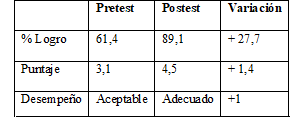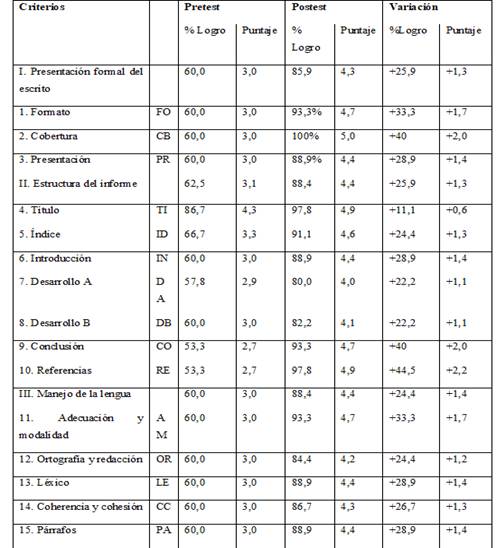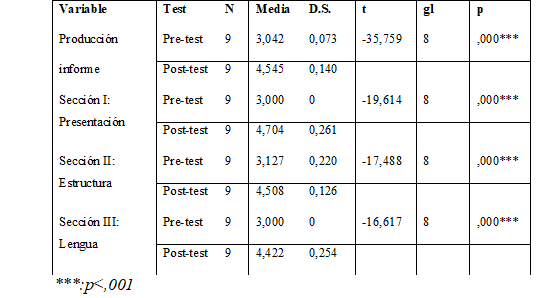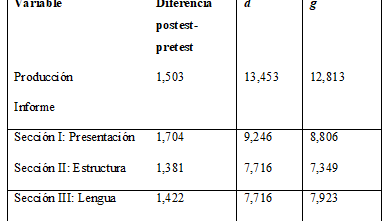My SciELO
Services on Demand
Article
Indicators
-
 Cited by SciELO
Cited by SciELO
Related links
-
 Similars in
SciELO
Similars in
SciELO
Share
EduSol
On-line version ISSN 1729-8091
EduSol vol.23 no.83 Guantánamo Apr.-June 2023 Epub May 03, 2023
Original article
Written production of the academic report in student teachers: a methodological intervention
1Universidad del Bío-Bío, Chile.
The purpose of this research is to determine the effect of the application of a methodological intervention in the classroom that considers the writing process approach and project-based learning (PBL) on the level of mastery of the production of an academic report by 36 students of Pedagogy in Spanish at a regional state university. The research approach is quantitative and with a quasi-experimental design. The experience showed that the students comply adequately with the formal presentation of the report, although the challenge is to continue advancing in the processing of the information.
Key words: Writing; Academic report; Pedagogical intervention; Pedagogy students
Introduction
In university studies, the use of academic writing is indispensable as a means for the construction of knowledge, the evaluation of learning and the development of critical thinking, among other purposes that arise at this level. Specifically, among the basic professional skills that should be considered in the training of a pedagogue, is the "ability to communicate orally and in writing effectively, coherently and correctly, in various professional contexts" (Ministry of Education, 2012, p. 15).
That is to say, future teachers should not only use this linguistic tool (writing) in the daily need for academic, professional and social communication, but, above all, approach its teaching in the classroom, following appropriate and relevant didactic guidelines and designs, which encourage teachers, in short, to act as linguistic models for their students.
One of the discursive genres that students must produce, and which is required in more than one subject from the first year of university entrance, is the 'academic or bibliographic report', which on several occasions is used as an evaluation instrument or activity. However, when the writing of this genre is raised in the classroom, we proceed by emphasizing the product approach -as it usually happens with the written production of most academic texts-, that is, the concluded text and not the process approach Didactext Group, 2015), which would lead to an optimal textual construction. Furthermore, we agree with Núñez (2020) in the sense that the report is a genre not explored in depth in its formation.
Several researchers have studied this academic genre such as Harvey and Muñoz (2005), Tapia and Burdiles (2009), among others, focusing on the representation that different actors have of it in the university environment, as well as its description in different disciplines, although the absence of a didactic treatment in the writing of this relevant and assiduous genre of higher education is observed. Following the guidelines of Parodi (2008), we have characterized the report as a discursive genre whose macro-purpose is to inform about facts, theories, situations or specific topics through the analysis, description, explanation, exemplification or development of topics from different disciplinary fields with objectivity and consultation of different bibliographic sources following a system of rules. Its context of circulation is academic and is produced by students in a learning situation and is generally used as an evaluative strategy in various disciplines of higher education.
Gradually, research on the approach to the process of written composition is beginning to delve deeper into key elements related to regulation and collaborative work in the act of writing, whether between teacher and student or between peers. In this regard, Corcelles, Cano, Bañales and Vega (2013) highlight, peer-to-peer help through groups, tutorials or collaborative revisions of the text have also proven to be an effective tool to facilitate the accompaniment of students throughout their writing and research process. There is no doubt that these orientations favor the use of strategies or methodological mechanisms for motivated, authentic and situated writing, and whose learning is truly meaningful.
One of the central didactic devices applied in this research was the design and implementation of a methodological intervention that allowed the production of an academic report, integrating an active and participatory methodology such as project-based learning (PBL). In general terms, PBL is a single process, consisting of a set of controlled activities, with start and end dates, carried out to achieve an objective in accordance with specific requirements, including time, cost and resource constraints (Galeana, 2006).
This methodology implies the generation, therefore, of "a writing project with a freely chosen work plan, through which one intends to do something of interest, be it a task to be done (such as, in this case, writing an academic report). It is about doing something, which implies learning to do things and learning about what is being done with the help of various instruments" (Álvarez, 2010, p. 91).
In this way, this project is put into practice thanks to the methodological intervention, which consists of a didactic sequence made up of a "series of activities and exercises according to a gradual order that tries to progressively solve the students' difficulties and facilitates the awareness of the linguistic and textual peculiarities of the different texts we work with" (Álvarez, 2010, p. 93).
Specifically, the project considers the implementation of a didactic sequence through an academic writing workshop, entitled "How to write an academic report?" with two weekly sessions of two hours each, for five weeks and a total of 20 hours.
Table 1 presents, on the one hand, the most relevant stages of project-based learning (PBL) according to Galeana (2006) and, on the other hand, it shows a synthesis of the key stages and phases of the methodological intervention that considers the process approach and textual metaproduction Grupo Didactext, 2015) and the didactics of writing discursive genres (Navarro, 2019).
Regarding PBL, the researcher explains what this methodology consists of before carrying out the didactic intervention and guides nine work teams in the elaboration of the project that is carried out, taking into consideration the planned stages (in Table 1 they are expressed in questions). Once the writing project (elaboration of the academic report) has been shared and provided with feedback, the intervention is carried out and, finally, evaluated as a project.
Table 1 Synthesis of the Academic Writing Workshop How to write an academic report? Project-based learning and didactic sequence of writing as a process
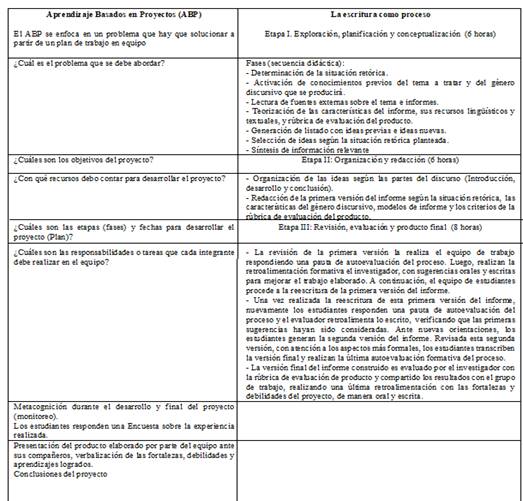
Source: Self made
Thus, this article presents the results of an investigation whose general objective was to determine the effect of the application of a methodological intervention in the classroom, centered on the process approach and project-based learning (PBL), on the level of mastery in the production of the discursive genre academic report by 36 students of Pedagogy in Spanish at a regional state university in Chile, as well as to analyze the findings obtained in this investigation and discuss the implications related to the writing of an academic text.
Development
The research approach is quantitative, with a pretest-posttest quasi-experimental design and nine work teams were involved (Hernández, Fernández and Baptista, 2014). For the purposes of this research, the statistical methods used for the analysis are Student's t-test, Cohen's d coefficient, Hedges' g coefficient and the use of Excel.
This research considers a purposive sample, made up of students taking the Communication Strategies course, taught in the 2nd year of the Spanish Pedagogy course, where the teaching of the written production of academic genres such as the report is effectively considered.
The total of the intervened subjects were n=36 (100%), where n=9 are men, which corresponds to 25% of the total sample and n=27 women, representing 75% of the total. For the application of the pretest and posttest and the elaboration of the academic report during the intervention, the course was divided into nine work teams with four members each, formed freely and spontaneously by the students themselves and who also chose autonomously the topics of their interest within the scope of their specialty, to carry out the project of generating an academic report.
In order to comply with the central objective of the research, the 36 students, divided into 9 work teams, had to previously elaborate a 20-page computer-based academic report as pretest, with a topic chosen by themselves, and with material they searched on the web, requiring four pedagogical hours for its execution; after the methodological intervention, each team had to present a final academic report that was considered as posttest, elaborated on computer with 20 pages with the same topic previously chosen.
For the review of the reports, a rubric was designed with the criteria adapted from the proposal for evaluating university academic reports by Tapia, Burdiles and Arancibia (2002), which were grouped into three sections and fifteen criteria with a value of 5 points each and with the assignment of a code: I. Formal presentation of the paper (FO Format, CB Coverage, PR Presentation). II. Structure of the report (Title TI, Table of Contents ID, Introduction IN, Development A DA, Development B DB, Conclusion CO, References RE) and III. Language management (Appropriateness and modality AM, Spelling and writing OR, Lexicon LE, Coherence and cohesion CC, Paragraphs PA). In addition, the rubric was structured on a scale of 1 to 5 points, with each figure corresponding to a performance level respectively: 1=Deficient; 2=Limited; 3=Acceptable; 4=Adequate and 5=Outstanding.
For the global categorization of the results of the sample, the same levels were taken into account and a holistic rubric was designed. The inputs generated to carry out the research were duly validated by means of a previous pilot test on a limited sample of similar characteristics and submitted to the judgment of experts, whose reliability was 80%.
During the process of methodological intervention, the students answered work guides and formative evaluation guidelines that oriented the progress of the work, related to the knowledge about the academic report that they put into practice, the application of textual production strategies, as well as the way of facing the difficulties of the process and their participation in project-based learning (PBL).
Results
Table 2 shows the overall group results obtained from the nine work teams from the evaluation of each of the academic reports produced, where a rubric containing fifteen criteria was applied. These results are shown in percentages of achievement (%), scores and assignment of a performance. Based on this information it is possible to present which were those with the highest and lowest achievement, as well as to compare the results of the students obtained in the pretest and posttest.
The nine work teams obtained, in global terms, 61.4% achievement in the pretest and 89.1% in the posttest, which shows a positive variation of +27.7%. Likewise, 3.1 points were recorded in the pretest, which shows an acceptable performance and 4.5 points in the posttest, with an adequate performance, whose positive variation was +1.4 points. It should be remembered that the achievement percentages range from 1% to 100% and the scores considered in the holistic rubric range from 1 to 5 points, so, to obtain which score (X) corresponds to N percentage, the simple rule of three is applied.
Table 3 shows the overall results of the groups obtained according to the criteria measured, with achievement percentages and scores in the pretest and posttest together with the corresponding variation, which can be positive (+) or negative (-), progress or regression.
In terms of percentages of achievement and pretest scores, section II. Structure of the report is the one with the highest performance with 62.5% and 3.1 points, followed by 60% and 3.0 points in sections I. Formal presentation of the writing and III. Handling of the language. It is in Section I where the highest and lowest levels of achievement are registered: 86.7% and 4.3 points in Title and Conclusion and References 53.3% and 2.7 points, respectively, which shows that students have no major difficulties in generating a title that integrates the key words of a report, but they are not able to elaborate an adequate conclusion with the main ideas addressed, brief discussion and projections, as well as references or bibliographic data following a system of norms such as APA.
These initial results are showing us that students, before the intervention, handle certain previous knowledge about the academic report genre used in higher education and also in school teaching, but, at the same time, they indicate that we must intervene to strengthen central parts of a report in the context of university academic requirements.
In the post-test, after executing the methodological intervention in the classroom, the following results are obtained: 88.4% and 4.4 points, coincidentally, obtained by Sections II and III, a higher grade than Section I with 85.9% and 4.3 points, all sections progressed more than two points compared to the pre-test. The criterion with the highest performance is coverage (number of pages), which achieves 100% mastery, that is, the students are able to write, in an outstanding manner, the 20 pages requested in the preparation of the report.
On the other hand, the lowest performance is registered in the criterion Development A with only 80% and 4.0 points, which means that the students adequately write the report, considering information processing through APA norms, generation of textual quotations and paraphrasing. On this point, it should be noted that the 'information processing' dimension is the most complex for students to learn, since it requires distinguishing, or rather, constructing very well their own 'voice' from the 'voice' of the authors addressed. That is, for Corcelles, Cano, Bañales and Vega (2013) "students must learn to use writing not only to describe knowledge, but also to develop their ideas and construct new knowledge" (p. 340). Although there was pedagogical support, the short time span of the intervention did not allow us to go deeper with more focused strategies of this relevant segment.
As for the data evidenced by the variation obtained after the post-test was applied, Sections I and II achieved a positive progress of +25.9% and Section III very close with +24.4%. Among the criteria with the greatest progress is References with +44.5%, which means that the subjects were able to record the bibliographic sources optimally with a system of norms such as APA, followed by Coverage and Conclusion with +40% of significant progress.
It is observed that Title only manages to advance +11.1%, but it is no less true that in the pretest it is already registered with a high percentage and score. The handling of the References was due to the fact that the students did not find it complex to apply them, given the clear and guiding examples that were presented in the course of the process. Meanwhile, in the Conclusion section there was significant progress, since during the intervention they applied information synthesis strategies such as recognition of subtopics and differentiation of main ideas from secondary ones, among others.
In sum, no negative variation was observed in any section; on the contrary, in the great majority of the evaluated criteria there was significant progress, which, visualized in Table 3, several of them achieved progress above 25% in the posttest (FO, CB, PR, IN, CO, RE, AM, LE, CC and PA), which demonstrates the effectiveness of the methodological intervention.
The results of the t-test indicate that these differences are significant for each of the variables analyzed. Likewise, the effect size is large in each of the cases. The results of the statistical analyses are shown below.
Table 4 presents the results of the comparative analysis between the pretest and posttest for the indicators of Production, Presentation, Structure and Language. First of all, the difference between the means of each of them is shown. In addition, the result of a paired data t-test is presented, which compares the posttest in relation to the pretest for each indicator. The result of this test shows that the differences are highly significant for all indicators, demonstrating that the methodological intervention had a positive impact.
Table 5 shows the effect size of the intervention, comparing the posttest with the pretest. For this purpose, Cohen's d coefficient and Hedges' g coefficient are calculated. In all cases, the coefficient obtained a value greater than 0.8, and is therefore considered "large". Comparing the sub-indices that make up the Production variable, the greatest effect is produced in Presentation, and the least in Structure.
Conclusions
The research conducted reveals that students are capable of producing an academic report, considering, in an appropriate manner, the vast majority of the dimensions or criteria evaluated after the implementation of a methodological intervention in the classroom based on project-based learning (PBL) and strategies of the process approach to textual production as well as mechanisms of collaborative and regulated writing. Above all, the teams conveniently comply with the formal presentation of the writing, in format and coverage, and a satisfactory handling of the language in terms of appropriateness, lexis and paragraphs. However, it is recognized that, although the statistical data reveal significant progress, in particular, it is necessary to strengthen the section of the body or development of the academic report mainly related to the processing of information, as the construction of their own voice as writers, distinguishing it from the other voices or authors cited.
In this regard, the didactic conditions must be created so that the following can be generated and worked on in academic writings: "the author self that is also constructed during the act of writing but which implies a higher level of explicitness and involves the feeling of authorship, the perception that the author dialogues with other voices to create his own discourse" (Castelló, Corcelles, Iñesta, Vega & Bañales, 2011, p. 108). This situation is undoubtedly related to the challenge that is also presented such as the efficient management of the citation system, avoiding copying, deductive ordering of information together with the transitions of the sections (verified in the criteria Development A with a 4.0 and in Development B with a 4.1).
Academic writing is configured as a transcendental dimension in the professional training of a future educator, as stated in the 'Guiding Standards for Secondary Education Careers' (Ministry of Education, 2012), forming an unavoidable part of the basic professional skills. Thus, the production of an academic report strengthens the capacity of the university student and future teacher in the search and processing of information, emphasizing bibliographic research skills.
Based on the experience gained, it is convenient to project the following actions in a future study that were not implemented in this opportunity. For example, in the proposal for the construction of an academic genre, it is indispensable to carry out research with a mixed methodological design, that is, not only the application of quantitative techniques, but also qualitative ones that gather relevant information about the regulation of writing in a more precise individual and group manner during the process, the students' perceptions during and after writing, which, according to Corcelles, Cano, Bañales and Vega (2013), still need to be investigated, and collaborative peer review based on the latest didactic approaches to academic writing and the use of ICT
Referencias bibliográficas
Álvarez, T. (2010). Competencias básicas en escritura. Octaedro. [ Links ]
Castelló, M., Corcelles, M., Iñesta, A., Vega, N. y Bañales, G. (2011). La voz del autor en la escritura académica: Una propuesta para su análisis.Revista Signos. Estudios de Lingüística,44(76). https://scielo.conicyt.cl/scielo.php?script=sci_arttext&pid=S0718-09342011000200001 [ Links ]
Corcelles, M., Cano, M., Bañales, G. y Vega, N. (2013). Enseñar a escribir textos científico-académicos mediante la revisión colaborativa: El trabajo final de grado en Psicología.REDU: Revista de Docencia Universitaria, 11(1), 79-104. [ Links ]
Galeana, L. (2006). Aprendizaje basado en proyectos. Universidad de Colima. http://ceupromed.ucol.mx/revista/PdfArt/1/27.pdf. [ Links ]
Grupo Didactext. (2015). Nuevo marco para la producción de textos académicos. Didáctica. Lengua y Literatura, 27, 219-254. https://revistas.ucm.es/index.php/DIDA/article/view/50871 [ Links ]
Harvey, A. y Muñoz, D. (2005). La evaluación en el discurso de informes escritos por estudiantes universitarios chilenos. En Pilleux, M. (Ed.). Contextos del discurso (pp. 215-228). Universidad Austral de Chile. [ Links ]
Hernández, R., Fernández, C. y Baptista, P. (2014). Metodología de la investigación. McGraw-Hill. [ Links ]
Ministerio de Educación. (2012). Estándares orientadores para carreras de educación media. Estándares pedagógicos y disciplinarios. Autor. [ Links ]
Navarro, F. (2019). Aportes para una didáctica de la escritura académica basada en géneros discursivos. DELTA, 35 (2), https://www.scielo.br/scielo.php?pid=S010244502019000200400&script=sci_abstract&tlng=es [ Links ]
Núñez, P. (2020). La organización discursiva de los informes escritos por universitarios en formación inicial. Perfiles Educativos, XLII (169), 36-51. [ Links ]
Parodi, G. (Ed.). (2008). Géneros académicos y géneros profesionales. Accesos discursivos para saber y hacer. Ediciones Universitarias de Valparaíso. [ Links ]
Tapia, M.; Burdiles, G. y Arancibia, B. (2002). Criterios para la evaluación de informes académicos de estudiantes universitarios”. REXE, 1(1): 117-125. [ Links ]
Tapia, M. y Burdiles, G. (2009). Una caracterización del género informe escrito por estudiantes universitarios. Letras, 51(79), 17-49. [ Links ]
Received: November 22, 2022; Accepted: February 15, 2023











 text in
text in 

